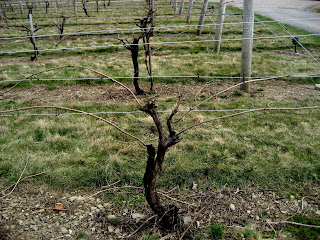 After the rough prune is complete, the next phase begins. This is a much more critical and deliberate pruning process, in which we decide which of the four canes will be used as the basis for growth for each individual vine throughout the year. They are the strongest, most prolific canes, which are 'laid down' into place along the the training wires.
After the rough prune is complete, the next phase begins. This is a much more critical and deliberate pruning process, in which we decide which of the four canes will be used as the basis for growth for each individual vine throughout the year. They are the strongest, most prolific canes, which are 'laid down' into place along the the training wires.Jewell Towne specifically follows a practice called VSP (Vertical Shoot Positioning) - a grape canopy management technique developed in New Zealand that allows cool climate grapes to make the most of the cooler environment.
From Enowiki, the free online winemaking encyclopedia:
"Vertical Shoot Positioning (VSP) is a training system that is used in conjunction with single or double Guyot, cane pruned training, or with a cordon, spur pruned system. VSP is very common in cool climate regions, with low to moderate vigorous growth, as it provides Better air flow
VSP encourages better air flow through the vine. This is accomplished by keeping all the shoots growing vertically, and no vegetative growth below the cordon/cane. The increase in air flow helps prevent problems associated with disease, allowing the fruiting area to dry out quicker after rains. Excellent sun for the fruit. With proper canopy management, the fruit is healthier, but being exposed to the sun earlier in the season, encouraging grapes to ripen more evenly within the bunch. Thinning and picking: Cluster thinning, and well as harvest is generally easier, as access to the fruit is easier. The objective of VSP is to train the shoots in a vertical fashion, creating a narrow layer that provides good sunlight exposure and air flow in the fruiting zone of the canopy. Each shoot is trained to grow vertically, in place, by attaching the shoot to movable catch wires. The shoots length can easily be controlled my pruning any vegetation over the top catch wire. The target for the fruiting zone is generally around waist-high, mainly for worker's convenience as the row are worked throughout the year."
"Vertical Shoot Positioning (VSP) is a training system that is used in conjunction with single or double Guyot, cane pruned training, or with a cordon, spur pruned system. VSP is very common in cool climate regions, with low to moderate vigorous growth, as it provides Better air flow
VSP encourages better air flow through the vine. This is accomplished by keeping all the shoots growing vertically, and no vegetative growth below the cordon/cane. The increase in air flow helps prevent problems associated with disease, allowing the fruiting area to dry out quicker after rains. Excellent sun for the fruit. With proper canopy management, the fruit is healthier, but being exposed to the sun earlier in the season, encouraging grapes to ripen more evenly within the bunch. Thinning and picking: Cluster thinning, and well as harvest is generally easier, as access to the fruit is easier. The objective of VSP is to train the shoots in a vertical fashion, creating a narrow layer that provides good sunlight exposure and air flow in the fruiting zone of the canopy. Each shoot is trained to grow vertically, in place, by attaching the shoot to movable catch wires. The shoots length can easily be controlled my pruning any vegetation over the top catch wire. The target for the fruiting zone is generally around waist-high, mainly for worker's convenience as the row are worked throughout the year."
Here is a simplified visual representation of VSP - after pruning and then with new growth:


And here we have the VSP system of pruning applied to our vines:


Next post - the long road to the final prune!
No comments:
Post a Comment